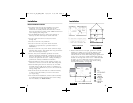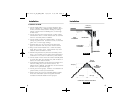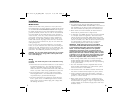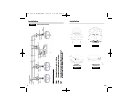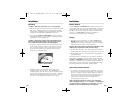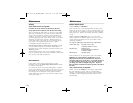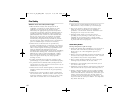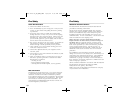
Locations to Avoid
• Do not install within 0.9 m (3') of the following: The
door to a kitchen, or a bathroom that contains a tub or
shower, forced air ducts used for heating or cooling,
ceiling or whole house ventilating fans, or other high
air-flow areas.
• Do not place the alarm where drapes or other objects
will block the sensor. Smoke must be able to reach the
sensor to accurately detect conditions.
• Do not install in peaks of vaulted ceilings, “A” frame
ceilings or gabled roofs. (Less than 10 cm (4") from the
peak of an “A” frame type ceiling.)
• Install at least 30.5 cm (12") away from fluorescent
lights as electronic noise may cause nuisance alarms.
• Keep out of insect infested areas. Avoid excessively
dusty, dirty or greasy areas. Dust particles may cause
nuisance alarms or failure to alarm.
• Extreme temperatures may effect the sensitivity of the
alarm. Do not install in areas where the temperature is
colder than 4.4°C (40°F) or hotter than 37.8°C (100°F).
• Do not install in areas where the relative humidity (RH)
is greater than 85%. Very humid areas, with moisture or
steam, can cause nuisance alarms.
• Avoid placing ionization smoke alarms in kitchen areas.
Normal cooking may cause nuisance alarms. If a
kitchen alarm is desired, it should have an alarm silence
feature or be a photoelectric type.
• Do not place in the garage. Particles of combustion are
present when you start your automobile.
• Smoke alarms are not to be used with detector guard s
unless the combination (alarm and guard) has been
evaluated and found suitable for that purpose.
I n s t a l l a t i o n
I n s t a l l a t i o n
5 6
IMAGE 2A
IMAGE 2B
HORIZONTAL DISTANCE FROM PEAK
CEILING
10 cm (4”)
MINIMUM
SIDE WALL
BEST
PLACEMENT
ACCEPTABLE
PLACEMENT
NEVER HERE
10 cm (4”)
0.9 m (3’) 0.9 m (3’)
NOT IN
THIS AREA
BEST
ANYWHERE IN
THIS AREA
1235-7219-02_AC_MAN_ENG 10/5/04 4:36 PM Page 4





